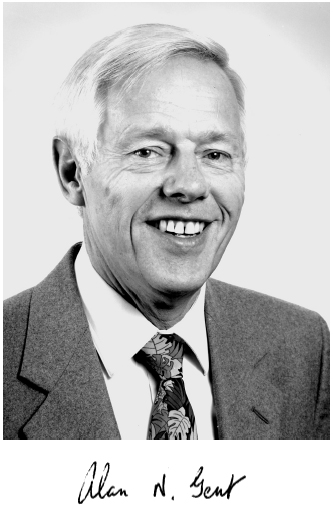
1927–2012
Elected in 1991
“For significant engineering contributions in adhesive and mechanical properties of polymers.”
BY STEPHEN Z.D. CHENG AND DONALD R. PAUL
ALAN N. GENT, the Dr. Harold A. Morton Professor Emeritus of Polymer Physics and Polymer Engineering at the University of Akron, Ohio, passed away on September 20, 2012, at the age of 84.
He was born in Leicester, England, on November 11, 1927, to Harry and Gladys Gent. He earned degrees in physics and mathematics at the University of London before receiving his PhD in 1955 on the mechanics of deformation and fracture of rubber and plastics. At the age of 17 he worked as a research assistant at the John Bull Rubber Co., then served the British Army in 1947–1949 before becoming a research physicist and later principal physicist at the British Rubber Producers’ Research Association, where he initiated a program in polymer engineering research.
In 1961 Gent joined the faculty at the University of Akron as professor of polymer physics in the Institute of Rubber Research. Two years later he was named assistant director of the Institute of Polymer Science, a position he held until 1978, when he was named Dean of Graduate Studies and Research. Eight years later he returned full-time to research and teaching, as a professor of polymer physics and then as the Dr. Harold A. Morton Professor of Polymer Physics and Polymer Engineering until his “unofficial” retirement in 1994.
He also served as consultant and scientific advisor to the research division of the Goodyear Tire and Rubber Company from 1964 to 2002.
Internationally known, Gent was widely regarded as the foremost expert on the fracture mechanics of rubber and plastics. His research yielded significant contributions to the world’s understanding of the physics of adhesion and the fracture of rubbery, crystalline, and glassy polymers. His work likely impacted nearly every rubber or plastic product developed today. He was also largely responsible for modern understanding of the strength of adhesive bonds; he identified and measured the separate contributions from chemical interaction (or reaction) between adherends, from rheological behavior of viscoelastic adhesives, and the fracture mechanics of simple adhesive joints.
During his distinguished career, he published more than 200 papers and book chapters on the mechanical properties of rubber and plastics, edited a book titled Engineering with Rubber (1992; now in its third edition), and was a coholder of two British patents and a US patent. He was frequently invited to address universities, corporations, and professional society meetings around the world and was a visiting professor at Queen Mary College at the University of London, McGill University, and the University of Minnesota. He also presided over three national scientific societies—the High-Polymer Physics Division of the American Physical Society, the Society of Rheology, and the Adhesion Society—and chaired four Gordon Research Conferences (on elastomers, cellular materials, adhesion, and composites). He served the National Academies as a member of the Panel on Technical Evaluation of NASA’s Proposed Redesign of the Space Shuttle Solid Rocket Booster and the Committee on Reliability of Adhesive Bonds in Severe Environments.
Gent was elected to the National Academy of Engineering in 1991, and his extraordinary teaching and research were recognized with numerous other honors and awards: the Mobay Award, Society of the Plastics Industry’s Cellular Plastics Division (1964); Bingham Medal of the Society of
Rheology (1975); Colwyn Medal of the Plastics and Rubber Institute (1978); Adhesives Award of the American Society for Testing and Materials International (1979); Society of Plastics Engineers International Research Award (1980); 3M Award for Excellence in Adhesion Science for the Adhesion Society (1987); George Stafford Whitby Distinguished Teaching Award (1987); Charles Goodyear Medal of the Rubber Division (1990); Medal of the Collège de France (1990); High Polymer Physics Prize of the American Physical Society (1996); NASA Distinguished Public Service Medal (1988); honorary degrees from the Université de Haute-Alsace, France (1997) and De Montfort University, UK (1998); the first Tan Sri Dr. B.C. Sekhar Gold Medal, instituted by Rubber Asia (2010); and the Inaugural Tire Technology International Lifetime Achievement Award (2012).
His colleagues recognized him as “brilliant and unassuming” and “both a remarkable scientist and a remarkable man.” From the beginning of his ties to the University of Akron, it was clear he possessed an extraordinary knowledge of and passion for his field. His pioneering work was coveted by global research and development firms, his contemporaries and students, and the university gratefully acknowledges Dr. Gent’s invaluable role in helping position it as a leading center for polymer science and polymer engineering research. Truly, Dr. Gent was a visionary scientist and educator.
Although Gent will probably be remembered primarily for his groundbreaking work as a scientist, his legacy is also that of an outstanding educator. He possessed a unique gift for bringing complex concepts into clear focus in both the laboratory and classroom, and during his lengthy career with the university he directed to completion more than 40 PhD dissertations and 35 MS theses. In honor of his international recognition and his service to the University of Akron, the board of trustees voted unanimously to change the name of the Ohio Research Scholar Professor at the University of Akron to the Alan N. Gent Ohio Research Scholar Professor of Polymers.
In addition to his passion for science, Dr. Gent’s hobbies included scouting, sailing, and collecting books. He served for
many years as scoutmaster for the Boy Scouts in both England and Silver Lake, and attained the rank of Queen’s Scout in England. Throughout his life, he was known for his warmth, humor, and generosity. He was a devoted family man and friend to all who knew him.
Gent is survived by his wife Ginger Lee, former wife Jean Gent, sons Martin, Michael, and Andrew, 15 grandchildren, and several great-grandchildren.






